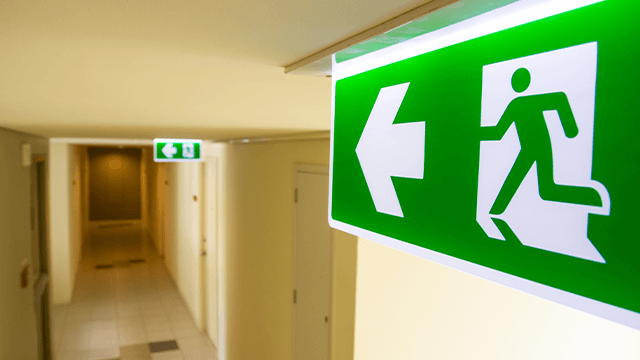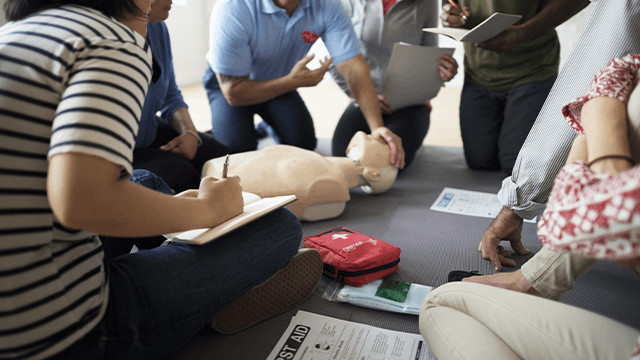In emergencies, the response's speed and accuracy depend highly on the actions taken in the first moments. To minimise harm, employers must warn employees to evacuate, take shelter or go into lockdown immediately. An emergency response plan (ERP) is essential to any business, helping managers and employers take the proper steps in times of crisis.
What is an Emergency Response Plan (ERP)?
An emergency response plan outlines the safety procedures for natural disasters, fires, or medical emergencies. It includes detailed information about responding to the crisis and protecting personnel. An ERP outlines:
- Evacuation plans, site layout, and emergency exits
- First aid and medical care instructions
- Employee roles and responsibilities during an emergency
- Contact information for emergency services and other relevant agencies
- Location of fire extinguishers and other emergency equipment
Developing and following an emergency response plan is an invaluable tool that businesses can utilise. The components that comprise this plan should cover a broad range of scenarios. From evacuation protocols and bomb threats to detailed medical emergency procedures, a first aid policy, and even communication strategies, an ERP should cover every possible emergency.
This way, businesses can rest assured that they are taking the essential steps to safeguard personnel if danger arises. Furthermore, by providing measures for effective crisis management, they will be better equipped to face any emergency.

Benefits of an Emergency Response Plan
Having an ERP in place provides a comprehensive framework that outlines the necessary steps to take in any emergency. It provides:
A transparent chain of command and an easy-to-follow timeline
During a crisis, the chain of command must ensure everyone knows whom to listen to in distress. An ERP should list appropriate personnel and protocols for communicating clearly and concisely.
Improved employee safety
Establishing a culture of safety with an ERP in place gives employees a sense of security, knowing their employer cares about their safety. Employees can feel more secure knowing their workplace is prepared for any emergency.
Better collaboration
By clearly establishing roles and responsibilities in an ERP, employees better understand the roles each person needs to fulfil during an emergency. This improves collaboration and coordination, resulting in faster response times and better outcomes.
Lower fatality rate
When employees are prepared and know the proper steps to take in a crisis, it helps reduce the time between when an emergency occurs and when help arrives. This can be the difference between life and death in many cases.
Reduced business disruption
An emergency response plan minimises the disruption to business operations. Operations can resume quickly with fewer safety hazards and less potential for liability.
Who Needs an Emergency Response Plan?
Emergencies can happen at any time, and no one is ever prepared enough for them. It's essential to be ready with an emergency response plan to prepare for anything. Any business that employs people should have an ERP, from small businesses to large institutions.
Certain groups should have emergency plans in place, such as:
- Businesses: Any business with employees should have a written document detailing how everyone should respond in an emergency. This includes both physical safety guidelines as well as potential property damage repercussions.
- Schools: Students can be particularly vulnerable during emergencies like natural disasters or a fire alarm going off unexpectedly.
- Medical Facilities: Hospitals, clinics, and nursing homes must have an emergency response plan that outlines what to do if something goes wrong during their operation.
- Governments: Governments are better prepared when disaster strikes their territories or population centres.
All types of organisations must create emergency response plans to handle any disaster or crisis better. Being proactive rather than reactive can mean preventing deaths and minimising injury or damage
Emergency Response Plan for High-risk Construction Work (HRCW)
Establishing an emergency plan for a workplace with higher-risk factors requires additional attention. This includes:
- Working with confined spaces that require special permits
- Handling heavy machinery and other dangerous equipment
- Working in environments with a high probability of hazardous materials, such as oil rigs or gas stations
- Working at heights
- Working around Asbestos
- Demolition and refurbishment work
Who is responsible for creating an emergency response plan?
Establishing an emergency response plan falls with the person conducting a business or undertaking (PCBU). This encompasses creating an effective strategy and testing it, maintaining its effectiveness and training workers to prepare them for any potential emergencies.
Furthermore, the PCBU must consider input from their workers and safety representatives when implementing or reviewing their emergency plans. This process must be adhered to guarantee the safety of everyone involved should an accident or incident occur.

Key Components of an Emergency Response Plan
Every emergency response plan should include the following components:
1. Emergency Evacuation Procedures
To ensure a prompt evacuation of employees, you should have a warning system that can be heard throughout the building. Place at least two exits from major hazard facilities on every floor. Test fire alarm systems to ensure they can be heard by all and use public address systems, air horns, or other alternatives. During planned drills, sound the evacuation signal to familiarise employees with it and ensure sufficient lighting leads to exits.
Assign an evacuation team leader, floor wardens, and "buddies" to help those with disabilities. Have a list of your workers and maintain a visitor log at the front desk so you can account for everyone during evacuations. Contact the fire department to develop a plan for persons with disabilities and determine alternate safe exits.
In the emergency procedures, you must include the following:
- Evacuation maps
- Location and type of emergency exits
- Instructions for using the fire extinguisher
- Floor plans indicating escape routes
- List of emergency contacts
2. Communication Systems
Another critical component of an emergency plan is the ability to communicate. Notifying employees and visitors is vital. Establish a chain of command so that one person is responsible for giving the "all clear" signal. This should include contact information for employees, visitors, and other responders.
Warning signs should be placed around the workplace to indicate an emergency is occurring and any special instructions for responding. Consider using a public address system or other communication devices to convey instructions to everyone onsite.
3. Emergency Response Teams
Designate specific personnel and train them for various emergencies to ensure an effective response. This team should be trained in first aid, CPR, and fire extinguishers. They should also have access to safety gear, such as protective clothing and breathing apparatus.
Here are the leading roles to consider as part of your emergency response team:
- Incident Commander: Responsible for the overall command and execution of the emergency response team.
- Safety Officer: Ensures the safety of personnel during an emergency and evaluates potential dangers that may arise.
- Communications Officer: Responsible for monitoring, logging, relaying and updating information to relevant parties involved in the emergency response.
- Medical/First Aid Officer: Provides medical assessment, care, treatment, and advice on medical emergency concerns during an emergency.
- Logistics Officer: Ensures availability of resources for personnel responding to an incident, such as food, water, protective equipment or first aid kits.
- Route Guides: Responsible for guiding personnel to safety by providing directions and assistance during an evacuation.
4. Emergency procedure training
Providing emergency procedure training to your workers is essential to workplace safety. Different types of training may be required depending on the individual, such as:
- Induction courses for new workers
- Refresher courses for existing workers
- Specific training for those with roles in times of emergency evacuation procedures
Furthermore, topics covered in these courses may include
- the evacuation and assembly point process
- the use of proper emergency equipment and emergency power supplies
- first aid guidelines
- safe shut-down methods for machinery
5. Policies and Procedures
Emergency policies and procedures that reflect your organisation's needs, employees, and local safety regulations are best. These policies should be tailored to each workplace and include the following:
- Emergency response procedures
- Evacuation emergency planning
- Designated emergency contacts
- Reporting requirements
These policies should be communicated to all employees so that everyone knows about the emergency response plan.
Tips for an Effective Response Plan
Here are some tips for creating an effective emergency response plan:
- Establish a concise response plan outlining all stakeholders' goals, roles, and responsibilities.
- Consider potential risks and the various approaches to mitigation.
- Be prepared for a quick response in the event of an emergency.
- Regularly review, update, and test your response plan to ensure it is comprehensive yet agile enough to respond to changing circumstances quickly.
- Ensure key personnel know their crisis responsibilities and have access to updated contact information for all team members.
- Integrate your response plan with other relevant policies, procedures, and methods, such as business continuity and risk management plans.
- Document all processes within the response plan so everyone understands expected actions when responding to a crisis or incident.
- Utilise document templates so that information is consistently updated and easily accessible. It will also save you time, knowing you don't need to start from scratch each time.
Emergency Preparedness For Every Workplace
When it comes to emergencies, preparation is critical. Emergency response plans (ERP), Recovery Plans and other safety documentation are essential in guiding employers and employees during an emergency. SafetyDocs by SafetyCulture is Australia's industry-leading emergency response and risk management plan provider.
Our safety documents are designed to help you develop a comprehensive plan for responding quickly and effectively to any emergency. It covers the key components and necessary steps to ensure employees are safe and secure during an emergency.
Check out our emergency response safety documents:
- Emergency Response Plan
- Disaster Recovery Plan
- Falls Emergency Rescue Plan
- Electrical Emergency Response Plan
- Emergency Response Procedure - General
- Emergency Worker Training Register
Get in touch with us today to get started on creating an emergency-ready workplace.
Available for instant download and supplied in fully editable MS Word format for use in your business.
Please note that the above information is provided as a comment only and should not be relied on as professional, legal or financial advice.
Share This Article
